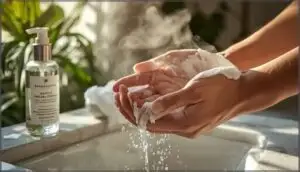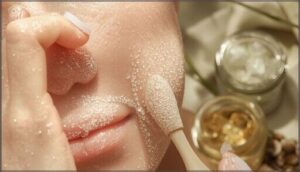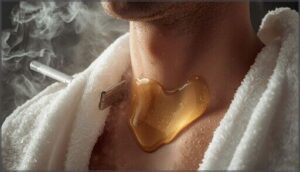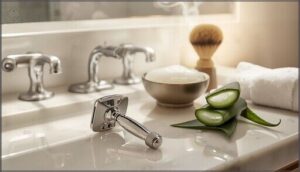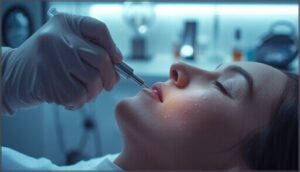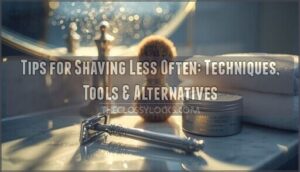This site is supported by our readers. We may earn a commission, at no cost to you, if you purchase through links.
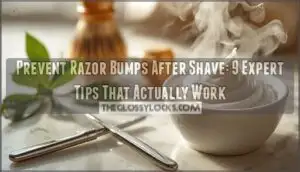
Use a sharp, clean razor with a quality shaving cream, and steer clear of close shaves and stretching your skin.
Afterward, apply a soothing balm and moisturizer to calm the skin. If bumps still play hardball, a dermatologist can step in with extra tools up their sleeve. Curious yet?
Table Of Contents
- Key Takeaways
- What Causes Razor Bumps After Shaving
- Pre-Shave Preparation for Smooth Skin
- Safe and Effective Shaving Techniques
- Essential Post-Shave Care Steps
- Top 9 Products to Prevent Razor Bumps
- 1. Philips Norelco Series 9000 Shaver
- 2. Philips Norelco Rechargeable Electric Shaver
- 3. Merkur Double Edge Safety Razor
- 4. Braun Mens Grooming Shaving Kit
- 5. Mens Exfoliating Face Care Scrub
- 6. Baxter Shave Tonic For Men
- 7. Healing Post Shave Soothing Balm
- 8. Pyunkang Yul Calming Moisture Balm
- 9. Korean Anti Aging Face Moisturizer
- When to Seek Professional Help
- Frequently Asked Questions (FAQs)
- How do I prevent razor bumps?
- How do you get rid of razor bumps after shaving?
- Is shaving a safe way to avoid razor bumps?
- What should I do if I get a bump after shaving?
- How do I prevent razor bumps after shaving?
- Does moisturizing after shaving prevent razor bumps?
- Does shaving every day prevent razor bumps?
- Does ice after shaving prevent razor bumps?
- How long do razor bumps typically take to heal?
- Are electric razors better than manual for sensitive skin?
- Conclusion
Key Takeaways
- Always shave with the grain using a sharp, clean razor and don’t rush the process.
- Exfoliate before shaving to clear dead skin and help prevent ingrown hairs.
- After shaving, moisturize your skin with a soothing, alcohol-free balm to calm irritations.
- Skip close shaves and avoid stretching your skin; gentle technique keeps razor bumps from forming.
What Causes Razor Bumps After Shaving
You’re dealing with razor bumps because your hair curls back into your skin after shaving, creating inflammation that shows up as red, irritated bumps.
Your genetics, hair texture, and shaving technique all work together to determine whether you’ll experience this frustrating condition that affects up to 80% of men with curly or coarse facial hair.
Ingrown Hairs and Hair Texture
Your hair’s texture determines razor bump risk. Curly hair and coarse texture create the perfect storm for Pseudofolliculitis Barbae. When you shave, these hairs curve back into skin, triggering inflammation around the hair follicle.
Consider these ingrown prevention factors:
- Coarse texture increases razor bump likelihood
- Curly patterns promote ingrown hairs naturally
- Hair follicle issues worsen with close shaving
Understanding your hair’s behavior helps target effective ingrown hair treatment.
Genetics and Skin Type
Your genetic predisposition plays a huge role in razor bump development. Up to 80% of affected men are Black, with curly hair texture increasing ingrown hair risk by 50 times compared to straight hair. The A12T gene mutation weakens follicle structure, making pseudofolliculitis barbae almost inevitable for carriers. Understanding the causes of razor bump scarring is essential for effective prevention and treatment.
| Risk Factor | High Risk | Lower Risk |
|---|---|---|
| Hair Texture | Curly, coarse hair | Straight, fine hair |
| Ethnic Background | African, Hispanic, Middle Eastern | Asian, Caucasian |
| Skin Sensitivity | Reactive, thin epidermis | Normal barrier function |
Shaving Techniques and Skin Irritation
Beyond genetics, your shaving approach directly impacts razor bumps and skin irritation. Poor razor maintenance and improper shave angle create the perfect storm for ingrown hairs. Without proper skin preparation and exfoliation methods, you’re setting yourself up for razor burn.
- Dull blades tug and tear at hair instead of cutting cleanly
- Shaving against the grain forces hair below skin level
- Skipping exfoliation traps dead skin cells around follicles
- Poor razor maintenance breeds bacteria that inflame skin
- Wrong shave angle creates sharp hair edges that pierce skin
Pre-Shave Preparation for Smooth Skin
You can’t skip the prep work if you want bump-free skin after shaving. Think of pre-shave preparation as laying the foundation for your house—without it, everything falls apart, and you’ll end up with irritated, bumpy skin that looks like you wrestled with a cheese grater.
Cleansing The Skin
Why skip the basics when they make all the difference? Cleanse your skin with gentle, noncomedogenic cleansers before shaving to clear pores and remove dead skin cells. This skin purification step prevents clogged follicles that contribute to Pseudofolliculitis Barbae.
Use a gentle facial cleanser with soothing ingredients like chamomile to prepare your face. Think of it as clearing the runway before takeoff—you’re setting yourself up for success from the start.
Exfoliating to Prevent Ingrown Hairs
Now that your face is squeaky clean, grab a facial scrub or chemical exfoliant. Exfoliating techniques like gentle circular motions clear out dead skin, giving trapped hairs a way out—no more Pseudofolliculitis Barbae nightmares.
Look for exfoliants with salicylic acid to tackle ingrown hairs fast. Think of it as spring cleaning for smoother skin and razor bumps prevention. Regularly checking for ingrown hair issues can help you address the problem early on.
Using Pre-Shave Oils and Warm Water
After exfoliating, set your pre-shave routine up for success with warm water and the right oil selection. Warming softens hair and opens up pores for better skin preparation. Pre-shave oils boost shave lubrication so your razor glides smoothly, dodging nicks and razor bumps.
Picture it:
- Steamy towel on your jawline
- Silky oil massaged in
- Razor just gliding
Safe and Effective Shaving Techniques
Shaving doesn’t have to feel like a wrestling match with your skin—there are proven methods to protect your face and avoid irritation.
By using the right technique and razor, you can dodge those stubborn bumps and keep your morning routine drama-free.
Shaving in The Direction of Hair Growth
After prepping your skin, stick to the direction your hair naturally grows. This isn’t just old-school advice—it’s about outsmarting razor bumps and ingrown hairs. Shave techniques that follow your hair’s “grain” cut friction, protect follicles, and calm your skin. Imagine it like mowing, not pllowing.
Here’s how it stacks up:
| Hair Growth Direction | Razor Angle Benefits |
|---|---|
| With the Grain | Less irritation |
| Against the Grain | More razor bumps |
Choosing The Right Razor and Shaving Cream
Just like shaving with the grain helps, your Razor Selection matters for smoother skin. Manual single-blade razors with stainless steel Blade Materials cut down on Razor Bumps. Handle Ergonomics save your grip mid-shave—no flying razors here.
Pair that with non-foaming, moisturizing Shaving Cream Types or even electric clippers, and you’ll notice better Lather Quality and fewer moments of Razor Burn.
Avoiding Close Shaves and Stretching Skin
For smoother shave techniques and less razor burn, skip the super-close shave and never pull your skin tight—it’s not a tug-of-war! Let your razor glide gently and respect your hair texture.
Shaving this way cuts down on ingrown hairs and stubborn razor bumps, making post-shaving care much easier. Trust the experts: gentle wins.
Using Short, Gentle Strokes
Once you’ve skipped the close shaves, focus on using short, gentle strokes. Imagine you’re painting tiny stripes, not plowing a field. Gentle strokes reduce tugging and skin trauma, key Shaving Tips for fighting Razor Bumps.
Keep your razor sharp and clean—Razor Maintenance matters. Combine good Stroke Patterns with steady Skin Preparation, and your face will thank you.
Essential Post-Shave Care Steps
Post-shave care isn’t just about feeling pampered—it’s a scientific step that keeps irritation and razor bumps at bay. If you skip it, don’t be surprised when your face wages its own tiny rebellion.
Applying Moisturizers and Soothing Balms
Once you’ve finished your shave, your skin needs some TLC. A quality moisturizer keeps skin hydration levels up and fights dryness. Go for soothing balms with Aloe Vera—your face will thank you.
Sensitive skin? Look for gentle balm ingredients. Got stubborn irritation? Sometimes a dab of hydrocortisone fits into smart after shave care.
Postshaving care isn’t just a bonus; it’s a must.
Gentle Exfoliation and Massage
Adding gentle exfoliation and Skin Massage into your PostShaving Care feels like hitting the reset button. Try exfoliating techniques like Gentle Scrubbing with a washcloth or choosing a facial exfoliant containing glycolic acid.
Skin Care Products that combine exfoliation with Soothing Touch keep bumps at bay. Throw in some Facial Steaming, and your skin—like your confidence—will glow.
Avoiding Irritating Skin Care Ingredients
Almost everyone with sensitive skin knows the gamble—one whiff of fragrance or a splash of alcohol, and razor bumps start plotting their return.
Avoid shaving creams packed with parabens, dyes, or comedogenic oils, and instead reach for aloe vera or hydrocortisone balms. These reduce skin irritation and save your face from the “red alert” zone of ingredient overload.
Top 9 Products to Prevent Razor Bumps
Choosing the right products can make a world of difference in your fight against stubborn razor bumps.
Let’s look at evidence-backed tools and treatments that’ll help keep your shaves smooth and your skin happier—no bandages required.
1. Philips Norelco Series 9000 Shaver
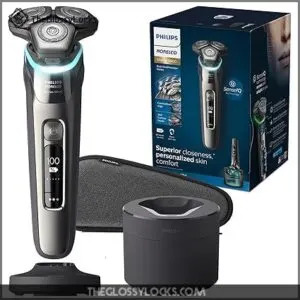
If you want to shave without fearing bumps, try the Philips Norelco Series 9000. This shaver’s 360-degree heads adjust to your face like a second skin, while SenseIQ tech eases up on pressure—no wrestling with friction or angry red patches.
It’s a lifesaver for men with curly or sensitive skin, cutting hair gently without yanking. Running late? It’s quick, easy to clean, and travel-ready. Think of it as your personal barber—no awkward small talk required.
Best For: Men with sensitive, easily irritated, or curly hair who want a gentle, close shave with less risk of bumps.
- Smooth, irritation-minimizing shave with adaptive SenseIQ and 360° heads
- Quick, easy cleaning and travel-ready design
- Long battery life and flexible wet/dry use
- Pop-up trimmer isn’t very strong for precise detailing
- Bulkier than some previous models
- Blades and cleaning pod require periodic replacement
2. Philips Norelco Rechargeable Electric Shaver
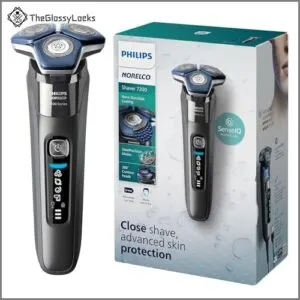
A trusty shield in your fight against razor bumps, the Philips Norelco Rechargeable Electric Shaver glides like a pro across your skin. Thanks to ComfortCut blades and flex heads, it’s gentle yet thorough—no acrobatics required.
You’ll love the fact that it works wet or dry and needs just a quick rinse to stay clean. For sensitive skin, this shaver keeps irritation at bay, making your morning routine a breeze instead of a battlefield. Time to ditch those old-school nicks!
Best For: Folks with sensitive skin or those looking to avoid irritation, razor bumps, and nicks from traditional shaving.
- Smooth gliding ComfortCut blades and flexible heads for gentler shaves.
- Wet or dry use with easy cleanup under running water.
- Reliable battery life with quick charging for on-the-go routines.
- Replacement blades are pricey at about $35.
- No travel case or wall adapter included.
- Some users report issues with nicking or the feel of independent heads.
3. Merkur Double Edge Safety Razor
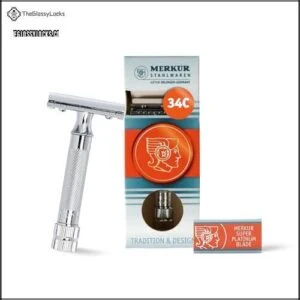
Craving fewer bumps after your shave? The Merkur Double Edge Safety Razor addresses ingrown hairs by using a sharp single blade and a gentle angle—no more five-blade overkill.
Glide with the grain, and let Merkur’s weighty handle do all the work. Users who switch say they notice less irritation and a cleaner look.
For best results, exfoliate beforehand and use short strokes. Sure, there’s a learning curve, but your skin will wonder why you didn’t start sooner.
Best For: Beginners and experienced shavers who want a smoother shave with fewer bumps or irritation, especially those with sensitive or curly hair.
- Smoother skin and fewer ingrown hairs compared to cartridge razors.
- Durable, high-quality build with easy cleaning and long lifespan.
- Affordable blades and accessible global availability.
- Takes practice to master for those new to double edge razors.
- Not as convenient to travel with or use on the go.
- Requires proper technique and regular maintenance.
4. Braun Mens Grooming Shaving Kit
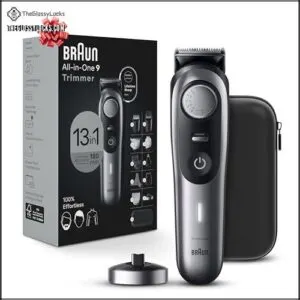
Braun’s all-in-one grooming kit is your Swiss Army knife for avoiding razor bumps. Skip the drama of nicks and irritation with ProBlade’s sharp-yet-gentle action and the precision wheel’s 40 settings—perfect for curly or sensitive hair.
Wet or dry, it responds to your skin’s mood, and attachments help you shape, fade, and detail without breaking a sweat. Toss it in the shower or your gym bag—this groomer takes the guesswork out of bump-free shaving.
Best For: Men who want a versatile, all-in-one grooming kit that’s gentle on sensitive skin and helps prevent razor bumps.
- Wide range of attachments and 40 length settings tackle everything from beards to body hair.
- ProBlade and AutoSense technology provide a close, comfortable shave with less irritation.
- Long-lasting battery and waterproof design support flexible use, even in the shower.
- Some users find the trimmer less sharp without guards and the shaver less precise than standalone razors.
- Not all accessories fit neatly in the included case, and the charging plug is not USB-C.
- Premium feel and durability may not match more expensive grooming devices.
5. Mens Exfoliating Face Care Scrub
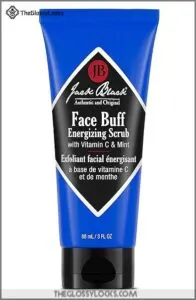
A good men’s exfoliating face scrub acts like a street sweeper for your pores, clearing out dead skin and trapped hairs before trouble starts. Dermatologists recommend using a gentle scrub, like Jack Black or Brickell, two to three times a week to help prevent razor bumps and ingrown hairs.
Go easy—a little goes a long way, and over-scrubbing can backfire. Use it before shaving for a smoother glide and less irritation. It’s a smart step for healthier, bump-free skin.
Best For: Men seeking to prevent razor bumps, improve skin texture, and maintain a smooth, healthy-looking face.
- Helps prevent ingrown hairs and bumps by unclogging pores.
- Preps the skin for a closer, more comfortable shave.
- Boosts skin radiance by removing dead skin cells.
- May be too abrasive for sensitive skin types.
- Some scrubs can be pricey compared to basic cleansers.
- Overuse can cause irritation and dryness.
6. Baxter Shave Tonic For Men
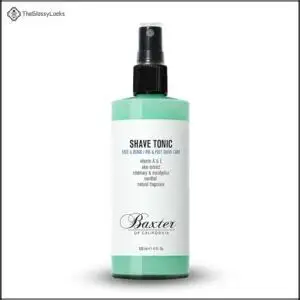
If you dread post-shave redness or those stubborn bumps, Baxter Shave Tonic for Men can be your secret weapon. Packed with menthol, aloe, and essential oils, it cools and calms skin right after your shave, like an ice pack for your face.
Just spray it on—a few quick spritzes—and you’ll feel refreshed. Bonus: it helps prevent ingrown hairs.
The scent’s bold but fades fast, leaving you with skin that looks—and feels—ready for anything.
Best For: Guys who want a quick, cooling solution to soothe skin, prevent razor bumps, and keep their face hydrated after shaving.
- Cools and refreshes skin with menthol, aloe, and essential oils.
- Helps reduce irritation, redness, and ingrown hairs after shaving.
- Works for sensitive, oily, and dry skin types; easy spray-on application.
- Scent can be strong and might not suit everyone’s tastes.
- Atomizer can leak or twist off, causing messy spills.
- Higher price compared to basic aftershave products.
7. Healing Post Shave Soothing Balm
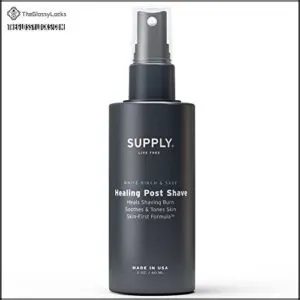
You know that sting after a close shave? Healing post-shave soothing balms are like a safety net for your skin. They use aloe, chamomile, or vitamin E to calm razor bumps, tame redness, and keep irritation from spiraling.
The best ones skip harsh alcohol and focus on hydration, so you’re not left feeling greasy or tight. Dermatologists love them for a reason: daily use keeps bumps at bay and your face ready for whatever the day throws your way.
Best For: Anyone dealing with post-shave irritation, bumps, or sensitive skin who wants fast relief without greasy residue.
- Instantly soothes redness and irritation with plant-based botanicals.
- Alcohol-free formula prevents dryness and stinging common to traditional aftershaves.
- Lightweight and travel-friendly; absorbs quickly for use anywhere.
- Scented formula might not suit those sensitive to fragrance.
- Not a heavy moisturizer, so may not hydrate extremely dry skin for long.
- Small 2.0oz size means frequent buyers may go through it quickly.
8. Pyunkang Yul Calming Moisture Balm
![Pyunkang Yul [PKY] Calming Moisture B08Q76Z7Y7](https://theglossylocks.com/wp-content/uploads/2025/02/pyunkang-yul-pky-calming-moisture-b08q76z7y7-300x300.jpeg.webp)
Guardian angels for your skin do exist—and Pyunkang Yul Calming Moisture Balm is a prime example. Packed with Centella Asiatica and five types of hyaluronic acid, it calms, hydrates, and shields sensitive post-shave areas from angry red bumps.
No greasy residue or harsh additives, just fast relief and a matte finish. Imagine post-shave comfort, minus the sting or shine.
Use it as your last step and let your face feel like it got the day off.
Best For: Anyone with sensitive, reactive, or freshly shaved skin looking for gentle hydration and fast post-shave relief.
- Soothes red, irritated, and sensitive skin with Centella Asiatica, peptides, and tea tree.
- Lightweight, non-greasy balm that absorbs quickly and leaves a matte finish.
- Free from fragrance, common allergens, and harsh ingredients—ideal for allergy-prone or eczema-prone users.
- Hydration may not be enough for very dry or parched skin types.
- Comes in a jar instead of a pump, which may be less convenient or hygienic for some.
- Texture could feel too light or too thick, depending on personal preference.
9. Korean Anti Aging Face Moisturizer
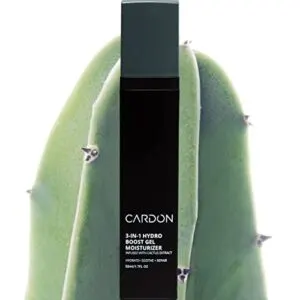
Every face could use a bit of TLC after a shave, and a Korean anti-aging face moisturizer steps up to the plate with featherlight hydration and barrier repair.
Packed with multitaskers like hyaluronic acid, niacinamide, and green tea, these creams hydrate, calm, and brighten without greasy buildup.
Daily use boosts elasticity, calms redness, and helps protect from stress. Just don’t slather it on right after shaving—give your skin a breather, then layer it on for bounce and lasting smoothness.
Best For: Men seeking simple, effective hydration and anti-aging benefits with lightweight, plant-powered ingredients.
- Deeply hydrates and soothes without greasy residue
- Boosts firmness, brightness, and barrier repair
- Made with premium, cruelty-free ingredients (niacinamide, cactus, green tea)
- Pricier than many standard moisturizers
- Small package size means limited product per purchase
- May be too light for those needing heavy nighttime moisture
When to Seek Professional Help
If your razor bumps keep coming back, look swollen, or just won’t quit, it’s time to let a dermatologist take a closer look.
Don’t wait until you’re tempted to play doctor with tweezers—professional care can save your skin and a lot of frustration.
Persistent or Severe Razor Bumps
If your go-to Razor Bump Remedies and bump prevention methods aren’t cutting it, it’s time to put stubborn Pseudofolliculitis Barbae in the hot seat.
When razor bumps stick around, become severe ingrown hairs, or turn painful, it’s smart to consult a dermatologist. They’re pros at specialized Pseudofolliculitis treatment, keloidal scar removal, and tackling chronic folliculitis.
Signs of Infection or Scarring
Spotting Infection Signs like redness, warmth, pus, or swelling around razor bumps is key—think of them as your skin’s SOS.
Scarring Symptoms, such as raised keloids or dark spots, can hint at long-term damage. If you notice skin lesions that don’t heal or feel painful, it’s time to rethink your Bump Treatment and consider Keloid Care.
Dermatologist-Recommended Treatments
If those razor bumps just won’t quit, it’s time for expert backup. Dermatologist advice often includes prescription treatments and Razor bump creams. These battle Pseudofolliculitis Barbae head-on.
Expect solutions like:
- Topical steroids or antibiotics
- Retinoids for stubborn cases
- Skin soothing balms (hello, Tend Skin)
- Ingrown hair removal tips, not tricks
Safe skin, happy face.
Frequently Asked Questions (FAQs)
How do I prevent razor bumps?
Shave with the grain and clip hair short—don’t chase that dolphin-smooth look. Hydrate with a moisturizing shave gel.
Exfoliate before and after. Avoid stretching your skin.
Switch to an electric trimmer if bumps keep crashing the party.
How do you get rid of razor bumps after shaving?
Kick bumps to the curb by gently exfoliating daily, moisturizing with salicylic acid, and using warm compresses.
Don’t pick—let stubborn hairs work themselves out, and give your skin a break until bumps heal.
Is shaving a safe way to avoid razor bumps?
Hold the razor—here’s the twist! Shaving can spark razor bumps, especially if you rush or cut too close.
To keep skin clear, use sharp blades, shave with the grain, and don’t press too hard.
What should I do if I get a bump after shaving?
Don’t panic if you spot a bump—just resist the urge to pick at it! Instead, use a warm compress, keep the area clean, and try a gentle exfoliant.
If it gets worse, see a dermatologist.
How do I prevent razor bumps after shaving?
Like a chess player planning ahead, keep your skin smooth by shaving with the grain, using a single-edge razor, and hydrating with a gentle, exfoliating cream—don’t rush, and your face will thank you.
Does moisturizing after shaving prevent razor bumps?
Moisturizing after shaving keeps your skin smooth, reduces friction, and helps outsmart razor bumps. Think of it as putting a comfy sweater on your face—hydrated skin is less likely to rebel with bumps or irritation.
Does shaving every day prevent razor bumps?
Imagine your razor gliding across a field of stubble each morning. Shaving every day can help, since short hairs have less chance to curl back in and cause bumps, but technique still matters—slow and steady wins.
Does ice after shaving prevent razor bumps?
Rubbing ice on your skin after shaving may cool things down, but it won’t keep razor bumps at bay.
Think of it as soothing the mood, not fixing the drama—prevention strategies are far more effective.
How long do razor bumps typically take to heal?
Razor bumps usually heal in 1 to 2 weeks if you leave them alone and resist the urge to pick.
Keep the area clean, moisturized, and be gentle—your skin can bounce back on its own.
Are electric razors better than manual for sensitive skin?
Think of it like choosing sneakers over dress shoes—electric razors are often gentler for sensitive skin.
You’ll skip the tug and nick routine, leaving your face happier and less likely to break out.
Conclusion
Prep right, shave smart, and care after—these steps help you truly prevent razor bumps after shave. Pay attention to exfoliation, always use the right razor, and don’t skip the soothing balm.
Address bumps early rather than letting them become a bigger problem. Armed with these evidence-based tips, you’ll keep your skin calm, comfortable, and bump-free. If those bumps persist, a dermatologist is your best ally.
Treat your face kindly—your future self will thank you.
- https://waxcenter.com/blogs/news/expert-tips-to-help-prevent-razor-bumps
- https://www.medicalnewstoday.com/articles/325471
- https://www.laserclinics.ca/blogs/how-to-avoid-razor-bumps-tips-for-smooth-bump-free-skin/
- https://www.health.com/razor-bumps-7558021
- https://www.aad.org/news/how-to-prevent-razor-bumps

